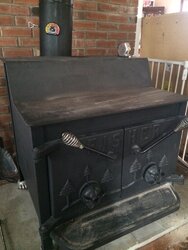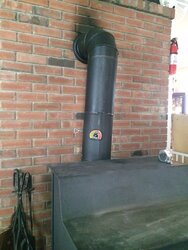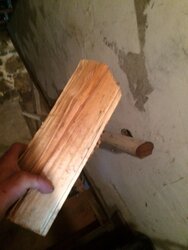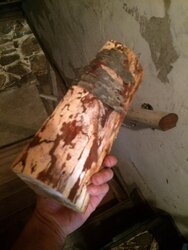Hi everyone, me and my wife just purchased a new house with a wood burning stove. I am not sure on how old it is or the model, the doors say fisher on the front and there is two knobs one on each door for the air intake. I tried using it for the first time last night and didn't work out so well. I couldn't seem to keep the fire going. I did some research on flue tempatures and I got myself a magnetic thermometer to put on the single pipe wall pipe, my chimney sweep suggested I keep the tempatures in the burn zone of 300-600 degrees. I couldn't seem to get the tempature up any higher than 200 degrees, I had the thermometer about 6" above the surface of the stove where the thermometer manufacture recommended. I seemed to never get any of the bigger logs to light and it would smolder out in about 20 minutes. I would have the air knobs completely opened with the doors shut. I started with just kindlen and fire starter logs and then put my bigger split logs in after it started going. Should I start the fire with bigger logs inside the stove? Should I be leaving the door cracked open till I get the proper flue temp? How long should the fire be burning till I see proper flue temp? Should I also have a thermometer on the stove top surface itself? Also how often should I be taking the ash out of the bottom of the stove? Basically I need any tips I can get cause I am totally new to this and am lost at this point. Thank you in advance for any advise
100% new to woodstoves
- Thread starter Asd1984
- Start date
-
Active since 1995, Hearth.com is THE place on the internet for free information and advice about wood stoves, pellet stoves and other energy saving equipment.
We strive to provide opinions, articles, discussions and history related to Hearth Products and in a more general sense, energy issues.
We promote the EFFICIENT, RESPONSIBLE, CLEAN and SAFE use of all fuels, whether renewable or fossil.
You are using an out of date browser. It may not display this or other websites correctly.
You should upgrade or use an alternative browser.
You should upgrade or use an alternative browser.
- Status
- Not open for further replies.
CrufflerJJ
Burning Hunk
First of all, WELCOME!
I don't have a Fisher stove, but as a person new to wood burning stoves, it's VERY IMPORTANT to realize that dry wood is important. Really dry wood is really important. Did I mention that your wood needs to be dry?
"Dry" has different meanings to different people. What is typically sold as "seasoned" by firewood peddlers is still waaaay too wet to burn well. Your wood may not really be seasoned. By this, I mean that it was cut from a tree, split, stacked, and allowed to air dry for at least a year (up to 3 years, depending on species of tree). If you try to burn wet wood, you get smoldering, low burn temperatures, and general unhappiness all around.
Others will chime in with the specifics on running your Fisher, but I'd first encourage you to check out your wood. Maybe try some bagged (kiln dried) wood that you pick up at your local Lowes or Home Depot. See how your stoove works with that stuff, compared to the wood you're trying to burn.
Good luck!
I don't have a Fisher stove, but as a person new to wood burning stoves, it's VERY IMPORTANT to realize that dry wood is important. Really dry wood is really important. Did I mention that your wood needs to be dry?
"Dry" has different meanings to different people. What is typically sold as "seasoned" by firewood peddlers is still waaaay too wet to burn well. Your wood may not really be seasoned. By this, I mean that it was cut from a tree, split, stacked, and allowed to air dry for at least a year (up to 3 years, depending on species of tree). If you try to burn wet wood, you get smoldering, low burn temperatures, and general unhappiness all around.
Others will chime in with the specifics on running your Fisher, but I'd first encourage you to check out your wood. Maybe try some bagged (kiln dried) wood that you pick up at your local Lowes or Home Depot. See how your stoove works with that stuff, compared to the wood you're trying to burn.
Good luck!
jatoxico
Minister of Fire
Hi and welcome. If you can please post a picture of the stove and chimney so we can see what you're dealing with. As mentioned you may have a wet wood situation in which case smaller splits and an "airy" fire will be needed. Your stove will be more forgiving of wet wood than a modern EPA certified stove but burning wet wood should be avoided as you'll get less heat and more creosote.
Would also like to rule out a clogged chimney pipe or other issue that's messing up your draft. Hopefully it was professionally cleaned and inspected. Low outdoor temps can slow the draft and create a lazy fire too.
If we can get some pics and establish a baseline of safety and proper install it will easier to get around to proper burning technique. It's not rocket science so don't worry in all likelihood you'll be happily burning in no time.
Would also like to rule out a clogged chimney pipe or other issue that's messing up your draft. Hopefully it was professionally cleaned and inspected. Low outdoor temps can slow the draft and create a lazy fire too.
If we can get some pics and establish a baseline of safety and proper install it will easier to get around to proper burning technique. It's not rocket science so don't worry in all likelihood you'll be happily burning in no time.
Poindexter
Minister of Fire
Second the idea of buying a 8-10 dollar bundle of firewood from Krogers or Home Depot or etc to see how that does.
You mentioned a chimney sweep. I ass/u/me you meant the sweep actually brushed out your pipe and looked over your install and said you are good to go?
You mentioned a chimney sweep. I ass/u/me you meant the sweep actually brushed out your pipe and looked over your install and said you are good to go?
jophysx
Burning Hunk
I would start by getting your chimney swept and inspected if you haven't already.
For the next step, use some kiln dried firewood from a store as previous posters recommended. Try keeping the door cracked open and monitoring what's going on inside during startup until you have a good, strong fire established, and your flue temperature is up in the 300-600 range. Then close it up and leave the air controls wide open while you monitor the temperature. The temperature might drop, but should recover and continue increasing. At this point, start slowly closing the air supply a little bit at a time. Each time, the flue temperature may drop a bit, but it should recover within 5-15 minutes. Keep doing this until the stove has hit a steady-state condition with the temperature in the burn zone. Once you get it there and it's steady, you can leave the air control alone. The temperature should hold steady for a while and then start dropping slowly. Leave it alone until the temperature gets back down to 200-300 range. Then you can reload.
You don't have to babysit it this close all the time. Just now while troubleshooting and learning how your stove likes to burn.
-Jim
For the next step, use some kiln dried firewood from a store as previous posters recommended. Try keeping the door cracked open and monitoring what's going on inside during startup until you have a good, strong fire established, and your flue temperature is up in the 300-600 range. Then close it up and leave the air controls wide open while you monitor the temperature. The temperature might drop, but should recover and continue increasing. At this point, start slowly closing the air supply a little bit at a time. Each time, the flue temperature may drop a bit, but it should recover within 5-15 minutes. Keep doing this until the stove has hit a steady-state condition with the temperature in the burn zone. Once you get it there and it's steady, you can leave the air control alone. The temperature should hold steady for a while and then start dropping slowly. Leave it alone until the temperature gets back down to 200-300 range. Then you can reload.
You don't have to babysit it this close all the time. Just now while troubleshooting and learning how your stove likes to burn.
-Jim




Here are some pictures of the stove and a picture of one of the logs of wood I have out of my stock, I got them from my boss's house he cut down a few trees last year they were not split till I got them about a week ago. I did have a professional chimney sweep sweep and inspect the chimney, he found a problem with the pipe going into the thimble being the wrong size, it was too short only about a foot long, and smaller than the thimble because the thimble is an oddball size, he also said that is where the black mark on the brick came from saying it possibly leaked back on really cold or windy days and recommended I get a pipe that goes all the way through the thimble, in which I did. I should also add it is a clay flue inside the masonary part of the chimney. Thanks again for all the feedback.
Pre 1980 Grandpa.
Read the manual first.
If you hear hissing or see any fluid bubble from logs ends it's too wet.
You should not have to leave doors open to start, and when you do, the fire screen must be in place.
https://www.hearth.com/images/uploads/Fisher_Manual.pdf
Read and use the search feature on this Forum - most all operating questions have been answered along with many burning tips.
Read the manual first.
If you hear hissing or see any fluid bubble from logs ends it's too wet.
You should not have to leave doors open to start, and when you do, the fire screen must be in place.
https://www.hearth.com/images/uploads/Fisher_Manual.pdf
Read and use the search feature on this Forum - most all operating questions have been answered along with many burning tips.
BlueRidgeMark
Feeling the Heat
Your wood is wet. If it wasn't split until a week ago, it's wet. Period.
I have the same stove but with the top outlet. Great stove, and not hard to use. The biggest thing is the wood. You need dry wood, no matter what stove you have.
I have the same stove but with the top outlet. Great stove, and not hard to use. The biggest thing is the wood. You need dry wood, no matter what stove you have.
jatoxico
Minister of Fire
Here are some pictures of the stove and a picture of one of the logs of wood I have out of my stock, I got them from my boss's house he cut down a few trees last year they were not split till I got them about a week ago.
Yeah gotta agree with BlueRidge. Wood barely dries until its split and then takes a year or more depending on what kind of wood and where you are. If you took a moisture meter to those splits they could easily be north of 35%. With wood that wet the fire will struggle. Try some scrap lumber or load of kiln dried and see how that goes.
Hi everyone, just want to do an update. We took everyones advice and went and got some firewood from home depot, we also got a box of enviro logs. We started the fire with the envirolog and added a couple pieces of the Home Depot firewood. This wood seemed to burn a lot better and I was able to get the stove in the burn zone. It put out plenty of heat and seemed to work great. So I'm probably gonna end up trying to buy another cord of wood and hopefully it will be dry enough to burn. Is there a specific amount of moisture the wood can have until it isn't a good idea to burn? Can I buy a moisture meter anywhere? Also should I be adjusting the flue dampner any while I'm trying to adjust temp or should I just leave it wide open and concentrate on the air dampners? Thanks again for the advice.
Also if I let it burn over night should I be worrying about flue temp? Should I turn down the air knobs? Or should I leave the knobs where they are and let it be?
+++Whatever wood you buy will be sub-par this time of year. Sellers like to say their wood is seasoned but it's probably seasoned by days not months. You can mix the drier stuff with the enviro logs or blocks. Get a cord and stack it in a sunny spot that gets wind so you have something for next year. Can't speak to the damper since I've never had a Fischer but I would leave it open until you have a good hot fire going then close it off a little at a time. If you get the flue too cold,- 250/300, creosote forms.Hi everyone, just want to do an update. We took everyones advice and went and got some firewood from home depot, we also got a box of enviro logs. We started the fire with the envirolog and added a couple pieces of the Home Depot firewood. This wood seemed to burn a lot better and I was able to get the stove in the burn zone. It put out plenty of heat and seemed to work great. So I'm probably gonna end up trying to buy another cord of wood and hopefully it will be dry enough to burn. Is there a specific amount of moisture the wood can have until it isn't a good idea to burn? Can I buy a moisture meter anywhere? Also should I be adjusting the flue dampner any while I'm trying to adjust temp or should I just leave it wide open and concentrate on the air dampners? Thanks again for the advice.
CrufflerJJ
Burning Hunk
Hi everyone, just want to do an update. We took everyones advice and went and got some firewood from home depot, we also got a box of enviro logs. We started the fire with the envirolog and added a couple pieces of the Home Depot firewood. This wood seemed to burn a lot better and I was able to get the stove in the burn zone. It put out plenty of heat and seemed to work great. So I'm probably gonna end up trying to buy another cord of wood and hopefully it will be dry enough to burn. Is there a specific amount of moisture the wood can have until it isn't a good idea to burn? Can I buy a moisture meter anywhere? Also should I be adjusting the flue dampner any while I'm trying to adjust temp or should I just leave it wide open and concentrate on the air dampners? Thanks again for the advice.
This moisture meter is in stock at your local Torrington CT Lowe's:
http://www.lowes.com/pd_78059-56005-MMD4E_1z0vin9__?productId=3136919&pl=1&Ntt=moisture+meters
Only trust test results on a FRESHLY SPLIT wood surface. If you just grab a big chunk of wood at random & check the surface, it might read pretty low. Once split, though, you're testing the inside of that piece (which contains most of the moisture).
It's too late in the season to expect to buy seasoned wood. You might consider using a mix of your existing wet wood, plus manufactured wood bricks (made from sawdust & the like). These are found under the names like BioBricks and ECOBricks. Your local Tractor Supply sells these:
http://www.tractorsupply.com/tsc/product/redstone-wood-fuel-pack-of-6?cm_vc=-10005
Good luck!
The key is knowing what makes the stove work. That is the chimney. Hot exhaust gasses are lighter than outside air and rise in the flue. (called draft) This creates a low pressure area in the stove allowing atmospheric air pressure to push into intakes supplying oxygen to the fire.
No one can tell you where to run your pipe damper. It is used to reduce excess chimney draft. The key is keeping flue temp above 250* all the way up. Below that temp, water vapor from combustion condenses on flue walls allowing smoke particles to stick. This can form creosote rapidly. An insulated flue liner requires the least mount of heat, indoor chimneys stay warmer than exterior. A larger flue size than stove outlet allows hot gasses to expand and cool, so there are a lot of factors including wood and weather that effect damper position.
ALWAYS make sure pipe damper is open before opening doors.
If you have a screen for open burning, the pipe damper is slowly closed until smoke rolls in at top. Open slightly to allow smoke to rise up chimney, this is the setting for the current burn to prevent all the heat from escaping, and slowing the fire. This becomes your only control with doors open.
Learn air intake control first by keeping damper open. Not all chimneys need to be slowed with the damper. Remember, closing the damper partially reduces the draft, which reduces the strength of the push through the intakes. Think of it as a throttle on your chimney, which affects the stove.
Check creosote formation near the top frequently until you know how much you create.
Start fire with air intakes open a couple turns. Close them down as it gets going. Normal setting is both about 1 turn open once up to temp. If too much heat, reduce by 1/4 turn increments for the heat output you need. You'll find the colder it gets outside, the better the stove works. It's all about the differential temperature between inside and outside of chimney flue. When it gets colder and more heat is required, you may find you need a turn and a half open. You won't have to open the air intakes a lot more, since as it gets colder, the chimney draft increases (pressure in stove decreases) allowing more push into the stove. You can see how low and high pressure areas moving over effect the available pressure pushing air in. You'll find during a low pressure area, you will need pipe damper fully open and air intakes open more to compensate for the less air pressure available.
No one can tell you where to run your pipe damper. It is used to reduce excess chimney draft. The key is keeping flue temp above 250* all the way up. Below that temp, water vapor from combustion condenses on flue walls allowing smoke particles to stick. This can form creosote rapidly. An insulated flue liner requires the least mount of heat, indoor chimneys stay warmer than exterior. A larger flue size than stove outlet allows hot gasses to expand and cool, so there are a lot of factors including wood and weather that effect damper position.
ALWAYS make sure pipe damper is open before opening doors.
If you have a screen for open burning, the pipe damper is slowly closed until smoke rolls in at top. Open slightly to allow smoke to rise up chimney, this is the setting for the current burn to prevent all the heat from escaping, and slowing the fire. This becomes your only control with doors open.
Learn air intake control first by keeping damper open. Not all chimneys need to be slowed with the damper. Remember, closing the damper partially reduces the draft, which reduces the strength of the push through the intakes. Think of it as a throttle on your chimney, which affects the stove.
Check creosote formation near the top frequently until you know how much you create.
Start fire with air intakes open a couple turns. Close them down as it gets going. Normal setting is both about 1 turn open once up to temp. If too much heat, reduce by 1/4 turn increments for the heat output you need. You'll find the colder it gets outside, the better the stove works. It's all about the differential temperature between inside and outside of chimney flue. When it gets colder and more heat is required, you may find you need a turn and a half open. You won't have to open the air intakes a lot more, since as it gets colder, the chimney draft increases (pressure in stove decreases) allowing more push into the stove. You can see how low and high pressure areas moving over effect the available pressure pushing air in. You'll find during a low pressure area, you will need pipe damper fully open and air intakes open more to compensate for the less air pressure available.
- Status
- Not open for further replies.
Similar threads
- Replies
- 1
- Views
- 812
- Replies
- 16
- Views
- 897
- Replies
- 4
- Views
- 632

